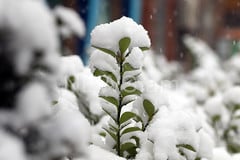Armenian News-NEWS.amcontinues Arianne & Armenia project within the framework of which Arianne Caoili tells about numerous trips across Armenia and shares her impressions and experience of living in Armenia.
Let’s talk about love
They say that the way to a man’s heart is through his stomach. But the way to an Armenian man's heart is through his past and future: at a respectable minimum, one must have the insatiable desire to hatch his future family, and have a sound appreciation of his country's major role in antiquity and the good old days of prosperity, struggle, subjugation, tragedy, and resplendent cultural exploits.
It sounds easy enough. But what about the opposite? How does an Armenian man - or even, Armenia itself -bewitch and beguile a foreigner towards the baffling and blood-soaked soil of Urartu? I would humbly suggest a mirrored answer: by revealing a charming, unmistakably unique past, and displaying a hope for and propensity (read: quality human capital) towards a glorious future.
This poses many questions concerning the government's tourism strategy, and indeed for repatriation (a movement which, by the way, is by far the most underestimated, overlooked and undervalued present-day solution for economic growth and to be more specific, productivity). I faced the dilemma of reeling in a fish with a fastidious appetite last summer: my sister, Rachel, came to visit me in Armenia. Attention, dear reader: this was Rachel's very first time in an ex-Soviet nation.
The prospect of being interred (even for but a week) in a land-locked country with extreme temperatures and a tinge of ethnocentrism (and which, by geographical association, is comically misrepresented to gullible foreigners by the iconically hairy Borat in a green thong, famous for anxiously chasing foreign girls, or by Ken Davitian playing the role of the grotesque and overexcited fur-ball, Azamat), did not prove as inviting as it sounds. Add to this the unfortunate fact that our subject does not eat onion, garlic, cheese, or anything of the green variety - which immediately rules out the majority of Armenian cuisine.
Yours truly, being simultaneously a non-tourist and a non-Armenian, admittedly had a difficult task: but I defended Armenia gallantly. I decidedly ignored the supremely easier but trite alternative of passing her off to unpleasant tour operators sitting upright on their plump behinds, making garrulous speeches from their overloaded bus seats. I also skipped the mandatory Sevan visitation. Compared to other jewels in the crown of Armenia's countryside, Sevan can appear to be a little over-promoted, with its restauranteurs encircling its shores, gesticulating on the size of their fish for sale, and water that is somehow more grey and undesirable than sun-kissed and inviting (a bit like biting into a ponchik with great expectations, only to find a disappointing amount of cream). No, Armenia has far more magnificence to reveal beyond lake Sevan.
With an itinerary carefully laid out, our guest was shown the best of Armenia according to me: exquisitely-detailed hikes around Dilijan and Aragats, picnics in the flowerbeds of Shirak, and personally designed walking tours of the uncommon Yerevan. Sharing something beautiful is never a tiresome thing, but true love is being unafraid of showing both the good and bad.
Rachel's binding motifs of Armenia, etched deep into her memory and countless photographs, were Mount Ararat and the tasty vegetables (namely, the humble tomato). In The Magician's Nephew, CS Lewis muses that "What you see and what you hear depends a great deal on where you are standing. It also depends on what sort of person you are”. To the average tourist, Ararat is a gorgeous mountain located in another country, where Noah's Ark allegedly landed on. For others, however, it is a symbol of 'the banality of evil', of centuries of stored up wrath, of omnipresent but untouchable beauty - all at once a solution, a problem, and a hope. But regardless of where one stands, Mount Ararat always arouses a coupe de foudre.
An issue our guest could not fathom was the amount of garbage in the city streets, and the accompanying aroma. There did not seem to be an acceptable justification for this amount of litter: the population size is hardly demanding on urban planners, and enough bins are provided. Something, Rachel noted, must be wrong with people's habits rather than mere infrastructure. I was thinking to myself, in a way that only thinkers who wish their thoughts to be silent do, 'you should visit Bangladesh or Massiv 9'. The garbage issue can be addressed without much effort, apart from a painless change in behaviour. Why do I care? Because it is my home. It is our home - and I love it. Let's be proud of it.
For many unprepared hosts came the surprise of Rachel's deep aversion to herbaceous paraphernalia and anything related to the onion. One thing our subject did adore was summer dolma (or rather more precisely, tolma, as one keen reader has pointed out to me - as it derives from the old Armenian world toli, which means grape leaf. Dolma, the Turkish alternative, comes from the word dolmak, meaning to fill something). Perhaps the tiny bits of chopped onion in the mashed up meat were small enough to hideout without getting caught out.
At one fine meal, Rachel asked if dolma was Armenian (because, as she began to point out with the sincere innocence of a child asking how they entered the world, someone had informed her that it was indeed not, and neither was 'Armenian' coffee, kyufta, lahmajo or jengalov hac). My pupils began to dilate and an inner monster rose up from the pit of my stomach, thumping on the door of my heart, demanding to take up arms against this seemingly harmless question. I defended dolma violently; and kyufta Ezhmiadzin; and even many other things that I knew were historically not solely Armenian.
Just as kindness leads one to be kind, my defence of Armenia was born from an innate sense of being shown the Armenian way, and of belonging to an Armenian group of friends which I unhesitatingly call my family. It goes without saying that I defended not only the food, but gushed about much more.
Rachel's visit was a well-planned, non-stop carousal. But ultimately, it was a test of how one might reveal something deeply loved, with all of the vulnerability of it being misunderstood, conventionally uninviting, and too easily forgotten after the final kiss goodbye. The result of the test was quite unexpected: it became an enactment of a recurring situation which I usually experience on the other side, as the foreigner, in one of those many fond moments when I fall into discussion with the neighbour or a stranger in a cafe or the shoe-repair man or my boxing trainer, who never cease to boast (whenever they get the chance, or whenever they can create the chance) about where the first grapes were planted; why Armenians are dominant in sports like weightlifting (apparently it is because their ancestors, as mountain people, evolved that way due to geographic necessity); how old the Armenian alphabet is (derived directly from heaven, as the very script of God himself); about the miraculous powers of Jermuk's waters; about the preeminence of Ani; and how Armenia is rising again as the Caucasian tiger.
Repressing all of my academic knowledge and even disregarding logic itself, I unashamedly reproduced these and other stories (some more accurate than others). But our guest actually did not require any car-salesman tactics to fall in love, and definitely did not need any convincing to proclaim that Armenian tomatoes are the best in the world - and on that account alone, she will be back.
Arianne Caoili
















